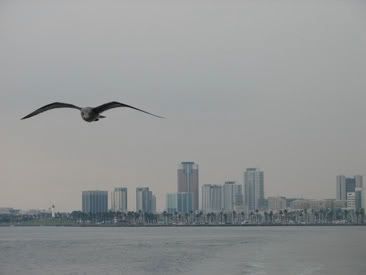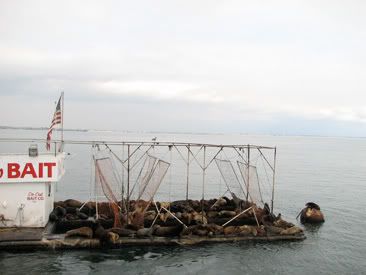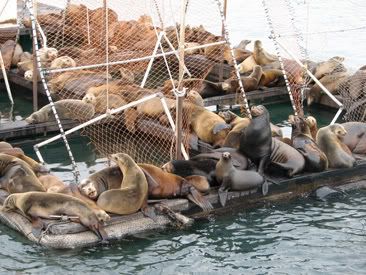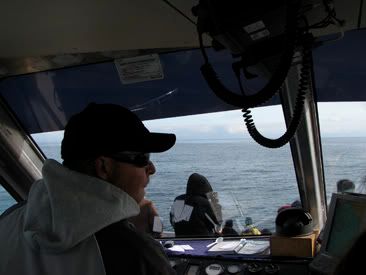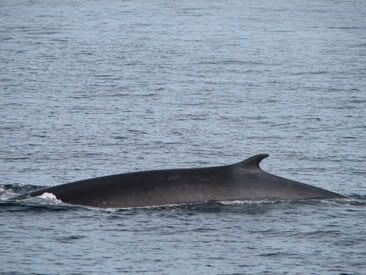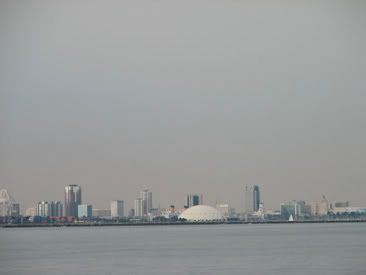
The Aquarium of the Pacific told us that the waters off of Long Beach’s coast are filled with a rare abundance of great whales — including blues, greys, and humpbacks. We told them to prove it.
Words and photos by Ryan ZumMallen
It’s not every day that you hear someone refer to a 110-foot whale as a “needle in a haystack.” But when searching for giants like the blue whale, the largest animal to ever live, the oft-used metaphor is a drastic understatement.
Blues’ tail flukes can equal a whale watching ship’s length, and spouts of breath can shoot 27 feet into the air. And the Santa Catalina Channel waters off of Long Beach’s coast are teeming with blues and others — finbacks, greys, humpbacks, orca — just like them. But when those are your only indicators, and your strategy for finding them is to drive out into open ocean and then look really hard, finding the largest animal to ever live gets difficult.
As we set out from the Aquarium to try our luck, I dipped into Captain Jason Wright’s cockpit to observe the strategy and escape the biting chill outside. Capt. Wright was acting on a tip from fishermen — is that ever a good idea, I wondered? — and headed for a 1,200-ft. ocean ridge just a few miles from the coast. Our tour guide from the Aquarium, Anitza, described the different species of birds escorting us out to sea, and described a past whale watch in which she had actually seen blue whales breaching – or leaping out of the water.
I thanked her for getting my hopes up too high, and headed for the deck at the sound of barking sea lions. An abandoned floating bait shop seemed to be crawling with them, warming their sleek bodies in the sun. Many of the sea lions in the water literally waved us off, though Anitza explained that keeping two fins and their dog-shaped heads above water is another way of warming up.
Finally we began to reach deeper water and crept towards the deep ridge that whales were reportedly hanging around. The strategy, at this point, is to idle the engines and keep your eyes peeled. It takes a trained eye, and the captain and guide almost always spot the giants long before the tourists do. This time, it’s proving to be a difficult task.
“I can’t believe we haven’t found them yet,” says Capt. Wright, who recently received a call that finback whales were in the area. “Look for the spout of air. You almost never spot a whale by their fluke.”
More waiting. Then Anitza points and yells, “There she blows!” Ignoring the humor in hearing that phrase used in a serious context, I shot a glance out to where she directed but saw nothing. Capt. Wright sees it right away, though, then another and another. He brings us in closer, and soon we’re surrounded by more than a half-dozen finback whales — giant mammals that can reach 90 feet in length, and are the second largest animals to ever live.
Finback whales, though, are also the most selfish and inconsiderate of all whales. When surfacing, their tail flukes never leave the water, so all that you’ll see is a quick spout from the blowhole and a glimpse of its long back and small dorsal fin. They surface seven or eight times before going into a deep dive to feed, from which they won’t return for about ten minutes.
Oh, and they’re fast. Really fast. In the early whaling days, finbacks continued to flourish because boats simply could not keep up until faster steam-powered ships were employed. They will rarely surface in the place you last saw them, and it takes a lot of luck to end up in the right place at the right time.
But there is something truly awesome about catching a fleeting glimpse of a real-life Leviathan, and realizing that what you’re seeing is less than 10% of the actual animal. It’s the ultimate “tip of the iceberg” example, and a humbling experience.
We hang out with the fins for a while and leave them to their feeding. About eight miles from the coast of Newport Beach, the cold is intensifying and we’re about ready to head back. But Anitza spots something against the Catalina outline. Spouts, lingering in the air for 4-5 seconds and reaching heights impossible for anything but a blue whale. Capt. Wright claims that even from miles away he noticed a fluke. There are probably two of them, maybe more, he says. But its too far — they could be completely gone by the time we get there.
I curse Anitza for the story of the breaching blues and wish I could have caught at least a glimpse of a fluke, but the wind is also starting to pick up and I don’t argue that it’s time to go. Heading back, we run head-on into a superpod of bottlenose dolphins — Capt. Wright estimates there are 500 or more (see video above).
“Don’t worry,” he announces on the intercom. “It’s impossible to hit a dolphin with the boat. They’re too fast.” Full steam ahead, and soon they’re everywhere — leaping towards us and diving at the last second. “Believe it or not, the best way to view these dolphins is to go as fast as possible, because they like to play in the wake of the boat. If we slow down, they’ll stop. We’ll be boring to them.”
The aerial acrobatics continue for miles — because they follow us that far or because the group is just that large, maybe both. They trail off as we near the harbor, and five Pacific whiteside dolphins make an appearance. They skurf in the boat’s wake for a while before the Port comes into view, and it is only then that I realize how close we remained to Long Beach the whole time. Ninety foot whales, dozens of sea lions and a small city’s worth of dolphins — just a few miles off shore.
Who knows what else is out there. The ocean surface doesn’t always look like much, but beneath it lies one of the greatest concentrations of marine mammals in the world. A simple glimpse of that world, and the realization that it’s so close in proximity to mine, is humbling at the least.

